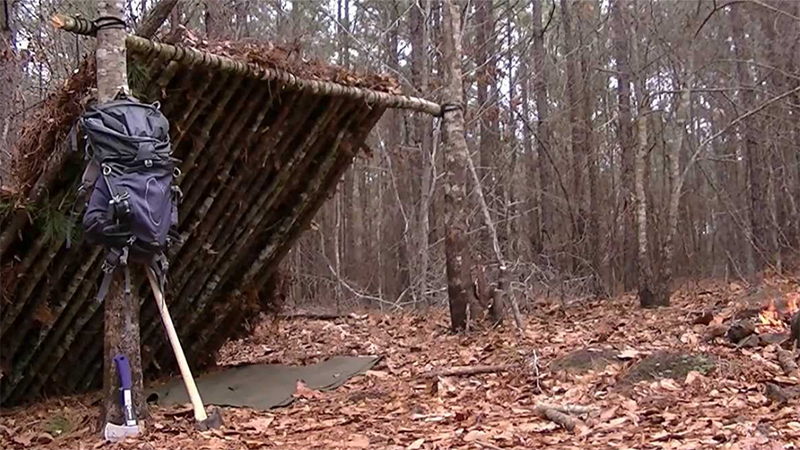The 7 Most Efficient Shelters for Survival
How
Important is a Shelter in a Survival Situation?
 1.Learn To Shelter
1.Learn To Shelter
 2.Tarp
Hammock
If
you’re in a wet or bug-infested area, it’s nice to have a shelter that keeps
your body away from the ground. In addition, the tarp hammock is very easy to
set up, so you won’t need to waste a lot of time getting it ready. This hammock
can even keep you safe against other animals like snakes. We recommend spraying
some bug repellent around the lines to make it even more effective.
2.Tarp
Hammock
If
you’re in a wet or bug-infested area, it’s nice to have a shelter that keeps
your body away from the ground. In addition, the tarp hammock is very easy to
set up, so you won’t need to waste a lot of time getting it ready. This hammock
can even keep you safe against other animals like snakes. We recommend spraying
some bug repellent around the lines to make it even more effective.
 3. Leaf Hut
3. Leaf Hut
 4.
Round Lodge
The
round lodge is a basic, effective design that can keep you safe against all of
the elements, as well as offering good protection against animals and other
threats. You can even start up a fire in this type of shelter, provided you
make it large enough. Before preparing your own round lodge, you’ll need to
gather a lot of long branches.
4.
Round Lodge
The
round lodge is a basic, effective design that can keep you safe against all of
the elements, as well as offering good protection against animals and other
threats. You can even start up a fire in this type of shelter, provided you
make it large enough. Before preparing your own round lodge, you’ll need to
gather a lot of long branches.
 5. Ramada
Sun Shelter
5. Ramada
Sun Shelter
 6. Quinzee
Snow Shelter
This
is a snow-based shelter formed in the shape of a dome, quite like an igloo. The
great advantage of the quinzee is that it can be prepared with almost any kind
of snow.
6. Quinzee
Snow Shelter
This
is a snow-based shelter formed in the shape of a dome, quite like an igloo. The
great advantage of the quinzee is that it can be prepared with almost any kind
of snow.
 7.
Natural Shelters
The
most energy-saving method is to use the natural shelter provided by geological
formations.Examples of natural shelters include caves, rocky crevices, clumps
of bushes, small depressions, large rocks on leeward sides of hills, large
trees with low-hanging limbs, and fallen trees with thick branches. However,
when selecting a natural formation:
7.
Natural Shelters
The
most energy-saving method is to use the natural shelter provided by geological
formations.Examples of natural shelters include caves, rocky crevices, clumps
of bushes, small depressions, large rocks on leeward sides of hills, large
trees with low-hanging limbs, and fallen trees with thick branches. However,
when selecting a natural formation:
A
shelter can protect you from the sun, insects, wind, rain, snow, hot or cold
temperatures, and undesirable observation from others. It can give you a
feeling of well-being and help you maintain your will to survive.
In
some areas, your need for shelter may take precedence over your need for food
and possibly even your need for water. For example, prolonged exposure to cold
can cause excessive fatigue and weakness (exhaustion) in a very short
time. If in doubt about the importance
of shelter, remember the “Rule of Threes”: You can survive 3 minutes without
air, 3 days without water, 3 weeks without food, and in extreme, harsh
environments – only 3 hours without shelter.
Selecting
the Site
When
you are in a survival situation and realize that shelter is a high priority,
start looking for shelter as soon as possible. As you do so, remember what you
will need at the site.
Avoid:
1.
Flash flood areas in foothills.
2.
Avalanche or rockslide areas in mountainous terrain.
3.
Sites near bodies of water that are below the high-water mark.
The 7
Most Efficient Shelters for Survival
 1.Learn To Shelter
1.Learn To Shelter
The
Lean-To is one of the most basic shelters you can set up. It doesn’t take long
to get this shelter built, and you don’t need a lot of resources to prepare it
either. It’s the ultimate low-maintenance shelter that is perfect for those
situations where you don’t want to spend too much time or energy to keep
yourself safe. As its name suggests, the lean-to is made by leaning several
branches against a solid support.
To
get this shelter built, you’ll first want to find a long, solid branch or pole.
You can then place this pole between a pair of trees. Then you simply have to
line up several other branches along one side of the pole to form a wall. You
can add leaves or grasses over the top of this wall for extra protection and
insulation.
The
lean-to won’t keep you particularly warm or safe, and it needs to be built with
the wall in the right area, otherwise the rain and wind will be coming into
your face.
 2.Tarp
Hammock
2.Tarp
Hammock
To
prepare your tarp hammock, you’ll need a simple tarp and some rope or cord. Put
the tarp flat on the ground and then roll one of the longer sides in towards
the center. Do the same on the side so that the two edges meet in the middle.
Next, tie some cord or rope at each end, leaving plenty free to tie around the
trees.
Try
to find some strong-looking trees that are about ten feet apart. Tie your
hammock around them, using half hitch knots for extra stability. Remember to
tie the hammock quite high up, as it will sink a little when you climb into it.
If you have an extra tarp, tie it above your hammock as a roof.
 3. Leaf Hut
3. Leaf Hut
It
has pretty good insulating and weatherproofing qualities that can save your
life during a crisis. This wedge-shaped, two-sided lean-to should be
approximately 10 feet in length.
Line
up thick sticks on two sides of a stump or rock, and then like a lean-to, fill
in the gaps between the sticks with mud, grass, pine needles, or leaves. It’s
important that you place the sticks close together so that your “filler”
doesn’t leak through into your sleeping area. If you’re in an area that’s
experiencing high wind, then add a layer of twigs or sticks over the entire
structure to prevent the vegetation from being stripped away.
 4.
Round Lodge
4.
Round Lodge
Making
the round lodge is simple. Stand up the branches in a circular pattern, with
each branch meeting the others in the middle, remembering to leave a gap at the
front for you to get in and out. Dig the bases of the branches into the ground
slightly for a bit of extra stability and security. Add grass or leaves over
the roof and walls for extra insulation.
 5. Ramada
Sun Shelter
5. Ramada
Sun Shelter
If
you’re in a sunny area, shelter might not seem as important, but it’s still
vital to keep yourself protected from the sun’s rays. Shade is your ally in
these areas, as issues like dehydration and sunstroke can quickly arise if you
spend too much time in sunny spots. A ramada is built with a flat roof to
provide a barrier between your skin and the sun’s UV rays. The good thing about
this shelter is its versatility; you can use a variety of materials to make the
roof.
To
prepare a Ramada, Simply dig four posts into the ground and then place the roof
over the top. Use a tarp or mat as the roof, tying it into place with rope or
cord, or find some large leaves and balance them in place with extra branches
and supports. This is an ideal shelter to set up in desert environments.
 6. Quinzee
Snow Shelter
6. Quinzee
Snow Shelter
To
make a quinzee, bundle your gear together in a ball, and wrap it up with a
tarp. Then pack snow all around the tarp, continuing until the snow is about
two feet in thickness. Gather around thirty or forty similarly-sized sticks,
with each one being about a foot in length, and insert them all around the
dome.
Finally,
dig your way into the dome and get your gear out. Get inside the dome yourself
and carefully excavate outwards until you see the bottoms of your sticks. Do
this for every stick to ensure that your dome is balanced all the way around.
 7.
Natural Shelters
7.
Natural Shelters
1.Stay
away from low ground such as ravines, narrow valleys, or creek beds. Low areas
collect the heavy cold air at night and are therefore colder than the
surrounding high ground. Thick, brushy, low ground also harbors more insects.
2.
Check for poisonous snakes, ticks, mites, scorpions, and stinging ants.
3.
Look for loose rocks, dead limbs, coconuts, or other natural growth than could
fall on your shelter.
Source: nwtoutfitters.com & Tim MacWelch


Comments
Post a Comment